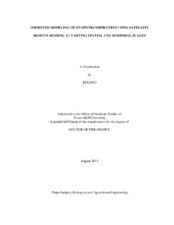| dc.description.abstract | The overall objective of the dissertation was to improve the spatial and temporal representation and retrieval accuracy of evapotranspiration (ET) using satellite imagery. Specifically, (1) aiming at improving the spatial representation of daily net radiation (Rn,24) under rugged terrains, a new algorithm, which accounts for terrain effects on available shortwave radiation throughout a day and utilizes four observations of Moderate-resolution Imaging Spectroradiometer (MODIS)-based land surface temperature retrievals to simulate daily net longwave radiation, was developed. The algorithm appears to be capable of capturing heterogeneity in Rn,24 at watershed scales. (2) Most satellite-based ET models are constrained to work under cloud-free conditions. To address this deficiency, an approach of integrating a satellite-based model with a large-scale feedback model was proposed to generate ET time series for all days. Results show that the ET time series estimates can exhibit complementary features between the potential ET and the actual ET at watershed scales. (3) For improving the operability of Two-source Energy Balance (TSEB) which requires computing resistance networks and tuning the Priestley-Taylor parameter involved, a new Two-source Trapezoid Model for ET (TTME) based on deriving theoretical boundaries of evaporative fraction (EF) and the concept of soil surface moisture availability isopleths was developed. It was applied to the Soil Moisture and Atmosphere Coupling Experiment (SMACEX) site in central Iowa, U.S., on three Landsat TM/ETM imagery acquisition dates in 2002. Results show the EF and latent heat flux (LE) estimates with a mean absolute percentage difference (MAPD) of 6.7 percent and 8.7 percent, respectively, relative to eddy covariance tower-based measurements after forcing closure by the Bowen ratio technique. (4) The domain and resolution dependencies of the Surface Energy Balance Algorithm for Land (SEBAL) and the triangle model were systematically investigated. Derivation of theoretical boundaries of EF for the two models could effectively constrain errors/uncertainties arising from these dependencies. (5) A Modified SEBAL (M-SEBAL) was consequently proposed, in which subjectivity involved in the selection of extreme pixels by the operator is eliminated. The performance of M-SEBAL at the SMACEX site is reasonably well, showing EF and LE estimates with an MAPD of 6.3 percent and 8.9 percent, respectively. | en |


